WoW Classic vs. Modern: What Has Changed Over the Past 15 Years
With WoW Classic's beta in full swing, we take a look at the early leveling experience in beta and the current WoW.
This article first appeared on USgamer, a partner publication of VG247. Some content, such as this article, has been migrated to VG247 for posterity after USgamer's closure - but it has not been edited or further vetted by the VG247 team.
World of Warcraft has never respected your time. It's a harsh taskmaster, trying to draw as much effort from you on a regular basis. In its current retail form, it wants you getting to the level cap, doing world quests, Island Expeditions, and Warfronts. With the Allied Races, eight of which exist at this point, you need to grind out Exalted and complete a quest line to unlock them. Then you have to level up these new characters from 1 to 120, to receive their Heritage Armor.
Where World of Warcraft has become kinder is in the smaller areas. This is readily apparent when you boot up World of Warcraft Classic, Blizzard Entertainment's time capsule that takes players back to the beginning of the MMO. The aim is the same-take up your time-but the way that it's done is different. I wanted to know how different, so I decided to test the early leveling experience in both games: modern World of Warcraft and World of Warcraft Classic.
For the purposes of the experiment, I avoided classes I normally play. Death Knight wasn't available until Wrath of the Lich King, while Paladin and Shaman were only worthwhile for certain specializations in vanilla. I've been playing in the closed beta as a Warrior and a Hunter, so those were out too. After browsing for some time, I went with a Rogue, a class I've barely touched in 15 years of WoW. So here are the adventures of Cutman: one Rogue, two different realities.

World of Warcraft Classic
The human part of World of Warcraft's campaign begins in the sleepy region surrounding the Northshire Abbey. Kobolds to the north, hogging the local mine, while the Defias bandits in the West have control of a local vineyard. All of your tasks are assigned by Marshal McBride, a gruff, no-nonsense commander who will seemingly draft any citizen to help him.
One thing that becomes quickly clear is that it's quite easy to miss things. Quest givers are marked in-world by the familiar golden exclamation point above their heads, but in vanilla, you actually have to see that confirmation visually. I actually missed the third quest I was supposed to get from Deputy Willem because, upon leaving the abbey, I immediately turned north. If a quest giver is inside a building, or in a direction you don't look, you will completely miss that quest. Design-wise, I assume this is meant to encourage exploration, making the player poke behind every nook and cranny. In reality, many of those crannies don't really have anything in the way of quests, so the outcome is generally you don't know that you've missed something.
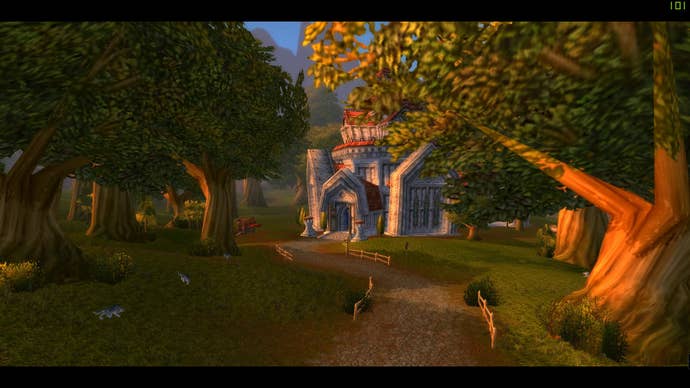
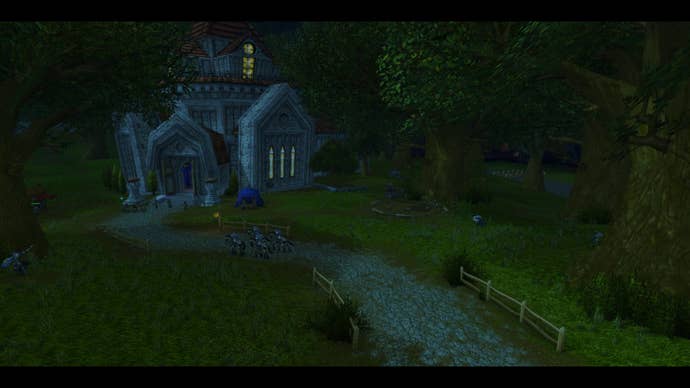
There's also the old familiar scrum in crowded quest areas. In Classic, if you attack a mob, you essentially take ownership of it, a concept called "tapping". A mob only offers quest completion and loot to the person that tapped it first, or members in that person's group. In a heavily trafficked quest area, this results in a mad dash: you'll see a mob and the race will be on to see who can hit it first. This benefits ranged characters heavily, or Warriors once they receive Charge. It's even worse if there's a named mob, as you'll get a group of players just standing around, cleaning up minions and hoping to tap the spawn first. The idea is to promote more grouping, since you finish quests faster if you work together. For named mobs, this actually does work sometimes. For regular quest mobs, it generally doesn't. Players just keep hunting around for the specific mob they need, hoping to hit it before anyone else. In the Fargodeep Mine, killing kobolds for Gold Dust and Melted Candles, it's rush for everyone; a wave of players trading mobs in hopes of getting the quest items they need.
Tapping also tends to lead to more competitive play. If someone taps a mob, and maybe pulls in more than they can chew, others will ignore them as they die because there's no benefit to helping. It's also common to fight your way towards a chest, named mob, or resource node, end up fighting an enemy right next to it, and then have it taken right in front of your eyes. This happened a few times with poor Cutman, though I did pay it forward by taking a chest as a Priest ran from three mobs. Thank you for your service.
I leave Northshire around level 5, making my way to the sleepy town of Goldshire. Here, questing opens up a bit, and there's more wandering. There are no markers showing you the region a quest objective may be in. You have to read the quest text, which offers landmarks and cardinal directions to work from. This definitely roots you within the world itself, but it also means that you'll do a certain amount of aimless wandering. Take the quest "Find the Lost Guards". The quest text tells you to follow the river north, but it's quite easy to miss the objective, a half-eaten body, because it's behind a tree. (This is why add-ons and websites like Thottbot, Wowhead, and Allakhazam existed back in the day.)
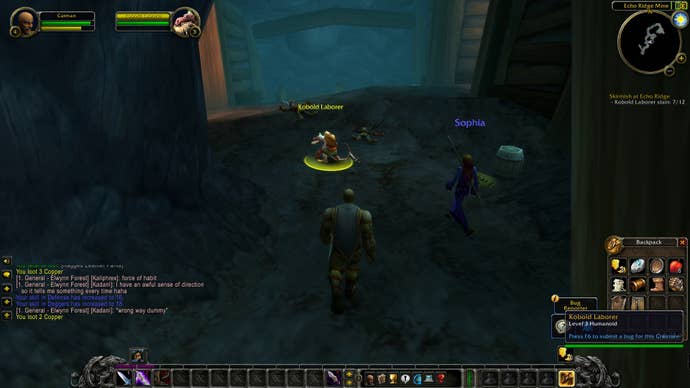
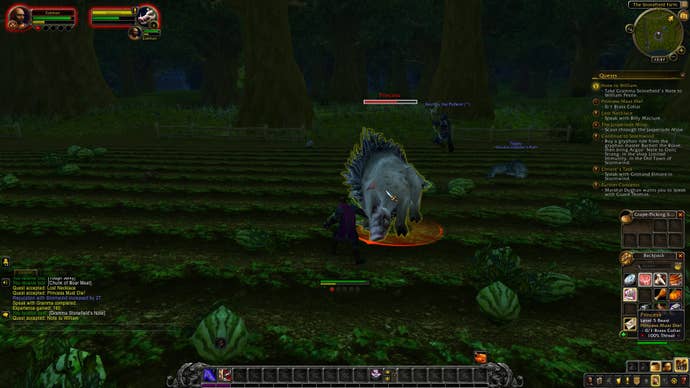
Quests are also a lot more spread out at this point. Going from Goldshire, to the Fargodeep Mine, to the Stonefield Farm, Maclure Vineyards, and Brackwell Pumpkin Patch takes a lot of hoofing it. This does increase the scale and scope of the world, but also eats up a lot of time where you're just auto-running places.
Classic has a lot of back and forth traversal that isn't just quest-related. There's your spells and abilities, which come via a trainer. For Rogues, it's Jorik Kerridan, who hides around back of the abbey, in the stables. Cutman begins with Sinister Strike and Eviscerate, while Jorik teaches you Stealth. At Level 4, you gain access to Backstab and Pick Pocket. You have to remember to jump back to a trainer as you level, otherwise you frequently end up running below your potential power. And you'll need all of it to survive.
The other reason you frequently return to hubs is to offload loot at local merchants. You start WoW with a 16-slot bag, and outside of generous Tailors making bags for folks with materials, you aren't like to get much more than a four-slot bag on the way to level 10. You're constantly running up against the limits of your inventory space in Classic.
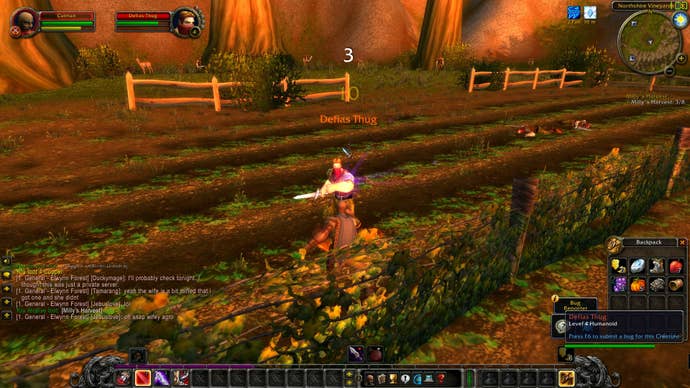
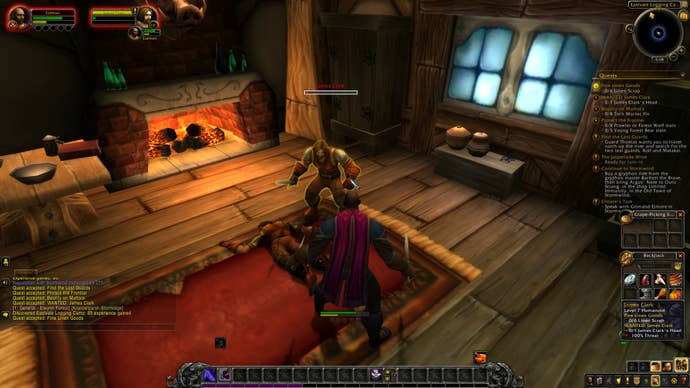
Your equipment is also pretty spotty. While I would find the occasional armor drop to improve Cutman's armor, weapons were pretty few and far between. I ended up purchasing another dagger in Goldshire. I was reticent to do so, since you need every copper and silver to train abilities and professions; but at one point, I was too far behind the power curve to ignore it any longer. You're definitely juggling your coin in Classic, weighing the best use of your limited resources.
I end my level 10 adventure on the east side of Elwynn Forest talking to Guard Thomas and letting him know the fate of his two guards. I didn't even make it to Hogger, probably the most infamous named mob in the human region of WoW Classic. After a walk all the way back to Goldshire, I train up and finally become what I consider to be a proper Rogue: gaining Dual Wield and Sprint for the first time. Unfortunately, this is Classic, so I can only dual wield daggers at the moment. I don't have the weapon skills for anything else. That would require visiting a weapon trainer, giving them money, and then wailing on low-level enemies to improve the new skill. More time, and more money I don't have. Shame.
Total Time to Level 10: 4 hours, 26 minutes

World of Warcraft: Battle for Azeroth
We return to the retail client, on the current expansion, Battle for Azeroth. My initial guess is that reaching level 10 in live will take a fraction of the time it did in the Classic closed beta. There's a host of quality-of-life changes and a general level squish due to 120 being the current level cap. Allied Races start at level 20, so this early section of the leveling experience should go pretty quick, I think.
The Cataclysm expansion saw the world redone to account for flying mounts and the in-game awakening of the mighty dragon Deathwing. Northshire Abbey hasn't changed much on the outside, but the areas around it have shifted in response. The northern area is no longer controlled by wolves and kobolds. Instead, Blackrock Orc spies and Blackrock Worgs are patrolling the area, while the Osworth Vineyards to the West are literally on fire due to assault by the Blackrock Clan. The quests are largely the same, but the focus has shifted a bit.
Cutman also starts out as a proper Rogue. You have dual-wielding and two daggers from the very beginning. Blizzard also removed weapon skill, so any one-handed weapon I find is actually usable, rather than fodder for merchants or the auction house. As Cutman levels up, new abilities are given automatically, with no need to return to your trainer. Oddly enough, poor Jorik Kerridan is still there; a trainer with no one to train anymore. Sad.

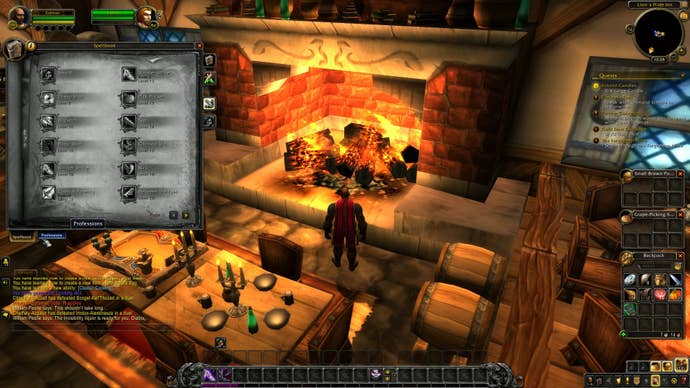
Rogue combat has also shifted a bit since the days of vanilla WoW. The human models were revamped in 2014, offering a new series of animations that are a bit more dynamic, but the mechanics are slightly different as well. In Classic, Rogues have two resource systems: Energy and Combo Points. Energy starts at 100, and refills in timed chunks on 20 points every few seconds (don't quote me on the exact number). Combo points are on the enemy; use an ability like Sinister Strike on an enemy and they'll get one combo point. Eviscerate deals more damage the more combo points you have on an enemy. In live WoW, combo points are now on the Rogue and energy regenerates on a consistent basis. The combo point change means you can build combo points on one enemy, and use Eviscerate on another, while the energy slightly changes the flow of combat. It's a bit faster and more free-flowing, mostly due to the new combo point system. (Stealth is also, much, much faster in the live game.)
Overall questing in crowded areas is also more cooperative, though it's almost like a Zerg rush over the local mobs. Tapping has also changed in current WoW: you get credit for any mob that you at least hit once. At later levels, this tends to devolve into a lot of area-of-effect attacks, where one player will gather up a bunch of enemies; but from level 1-10, no one has AOE. Instead, players run around like mad men, hitting anything and everything. Players will come and help you finish off a mob. I made an impromptu unofficial group with a Warrior at one point, working together to tackle a murloc camp. It also means fewer chances to miss named mobs, as whoever's in the area just works together to kill it.
Questing is vastly different in modern WoW. While the original thrust of vanilla was the journey itself, that journey is only powerful and meaningful the first or second time you go through it. That doesn't even take into account the players that would just look up quest solutions and objective coordinates on Wowhead or Thottbot. In current WoW, quests are the things you do to level to get to endgame. As such, quest givers and objectives are now marked on the mini-map, and mobs you require for a quest are clearly shown on their name plate. You always know where you need to go in modern WoW, which is very helpful if you're trying to level fast, but it takes away from the mystique and grandeur of the adventure.

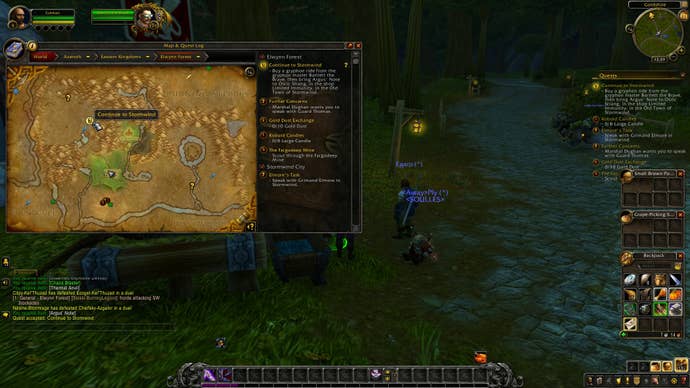
Another change is in regards to equipment. Quest rewards in WoW Classic are haphazard, with a quest giver offering the same rewards to everyone. In modern WoW, quest rewards are tuned to your character, so as a Rogue I was always getting daggers and leather armor. Inventory space is no longer a problem either. I ended my Classic run with the same 16-slot bag I started with. I ended my live run with the 16-slot, eight-slot, and two six-lot bags. This lowered the number of hub returns I needed to do, but it does feel like there could be a middle ground.
Speaking of getting around, modern WoW now has new flight points that didn't exist in Classic: Goldshire and the Eastvale Logging Camp to the east of Elwynn Forest. These allow you to move quickly between the two quest hubs, cutting down travel time. A number of players are clearly leveling alts and have a mount, the Chauffeured Mekgineer's Chopper, which allows a level one player access to a 60% speed mount. This meant I saw players just zooming around the area, while I tried to stick with an entirely fresh experience.
Outside of the Northshire area, the quests in Elwynn Forest are mostly the same in live versus Classic. This meant that even without the quest markers, I knew where to go. I ended up dinging level 10 on the far West of the map, after fighting Hogger.
Total Time to Level 10: 2 hours, 3 minutes
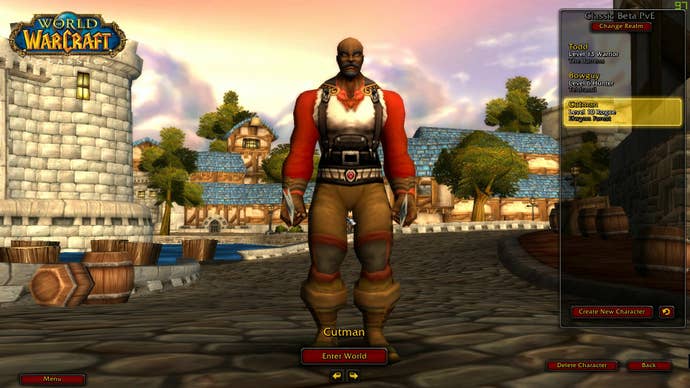

Half the time is higher than I expected. I thought it would be closer to a fourth of the time. Classic feels like the bigger experience for your first time in World of Warcraft, with more exploration and danger. It's easier to get lost or not see an objective, and it's much easier to die because of a lack of level scaling and focused rewards means you might be behind the power curve. There's a give-and-take in weapon skill, ability training, and profession leveling, because you don't have the money to do everything. You need to think carefully about what you're doing.
But there's also more frustration, like waiting for a specific mob to finish a quest or looking for a group in general chat and finding no one willing to join you. There's a lot of blank, boring travel time just running down a dirt road to turn in a quest, hit up your trainer, or offload a bag full of trash items. On my Warrior in the closed beta, I needed to run Ragefire Chasm to complete two quests. So I leveled up some professions while asking for a group in the general Orgrimmar chat channel. There were no takers in the hour I tried, so I ultimately just... didn't run Ragefire Chasm.
Modern WoW is built for these early levels to just be early levels. You blast through them onto the next thing. Getting a group for a dungeon is easy, as you can just queue up and you're teleported in once the group is complete. You always know where you're going, and you always know who wants you to do something. (There are secrets and hidden stuff, but usually centered on the more recent expansions, not the starting areas.)

I get the feeling that I might enjoy WoW Classic for what it is, but only once. It's not the kind of experience I see myself leveling multiple characters up in. WoW Classic is heading out into the woods to chop down a tree, cutting it up, sanding the pieces, measuring everything, and constructing a chair. I've built a chair. It's meaningful, it's satisfying, but it's not something I want to do for all the furniture in my home. I would not want to sit in my own chair, to be honest. Current WoW is Ikea. You buy it, the instructions are there, and at the end of it you have a chair. Sometimes, you'd much rather grab a whole dining set from Ikea, build it in an hour, and sit down.
It'll be interesting to see what kind of journey players will want when WoW Classic goes live on August 27, 2019.










